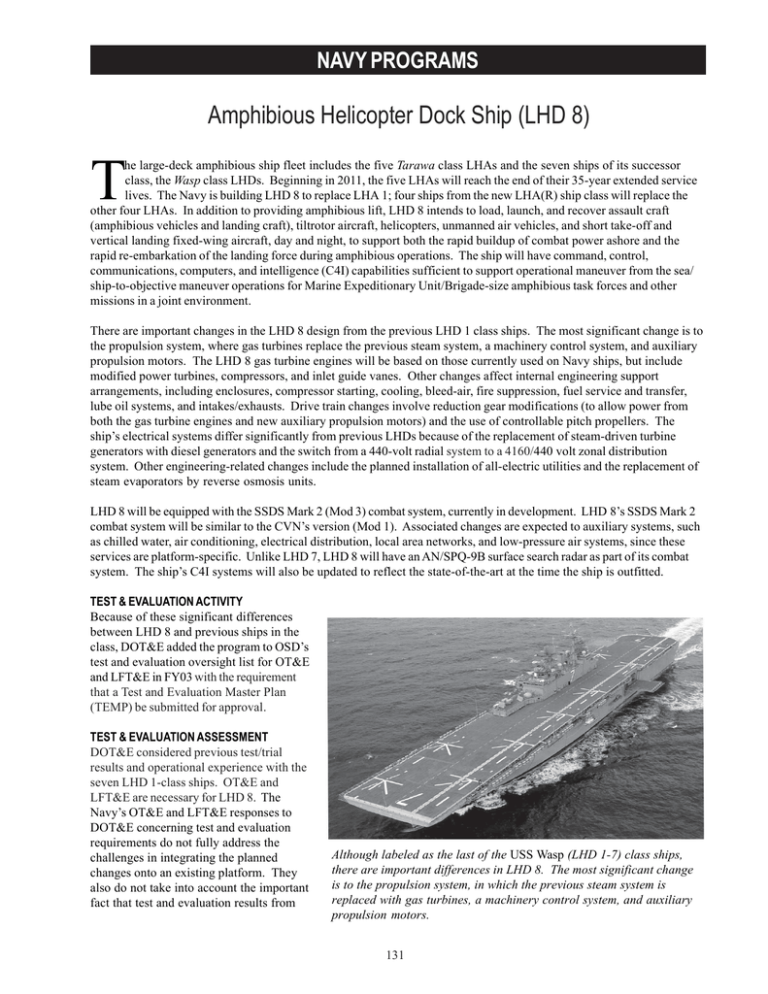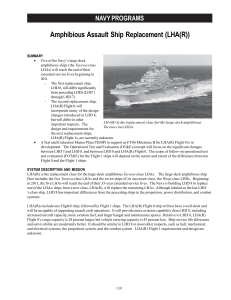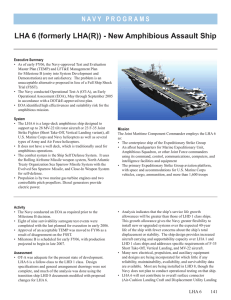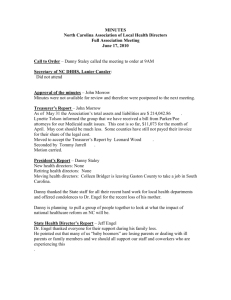T Amphibious Helicopter Dock Ship (LHD 8) NAVY PROGRAMS
advertisement

NAVY PROGRAMS Amphibious Helicopter Dock Ship (LHD 8) T he large-deck amphibious ship fleet includes the five Tarawa class LHAs and the seven ships of its successor class, the Wasp class LHDs. Beginning in 2011, the five LHAs will reach the end of their 35-year extended service lives. The Navy is building LHD 8 to replace LHA 1; four ships from the new LHA(R) ship class will replace the other four LHAs. In addition to providing amphibious lift, LHD 8 intends to load, launch, and recover assault craft (amphibious vehicles and landing craft), tiltrotor aircraft, helicopters, unmanned air vehicles, and short take-off and vertical landing fixed-wing aircraft, day and night, to support both the rapid buildup of combat power ashore and the rapid re-embarkation of the landing force during amphibious operations. The ship will have command, control, communications, computers, and intelligence (C4I) capabilities sufficient to support operational maneuver from the sea/ ship-to-objective maneuver operations for Marine Expeditionary Unit/Brigade-size amphibious task forces and other missions in a joint environment. There are important changes in the LHD 8 design from the previous LHD 1 class ships. The most significant change is to the propulsion system, where gas turbines replace the previous steam system, a machinery control system, and auxiliary propulsion motors. The LHD 8 gas turbine engines will be based on those currently used on Navy ships, but include modified power turbines, compressors, and inlet guide vanes. Other changes affect internal engineering support arrangements, including enclosures, compressor starting, cooling, bleed-air, fire suppression, fuel service and transfer, lube oil systems, and intakes/exhausts. Drive train changes involve reduction gear modifications (to allow power from both the gas turbine engines and new auxiliary propulsion motors) and the use of controllable pitch propellers. The ship’s electrical systems differ significantly from previous LHDs because of the replacement of steam-driven turbine generators with diesel generators and the switch from a 440-volt radial system to a 4160/440 volt zonal distribution system. Other engineering-related changes include the planned installation of all-electric utilities and the replacement of steam evaporators by reverse osmosis units. LHD 8 will be equipped with the SSDS Mark 2 (Mod 3) combat system, currently in development. LHD 8’s SSDS Mark 2 combat system will be similar to the CVN’s version (Mod 1). Associated changes are expected to auxiliary systems, such as chilled water, air conditioning, electrical distribution, local area networks, and low-pressure air systems, since these services are platform-specific. Unlike LHD 7, LHD 8 will have an AN/SPQ-9B surface search radar as part of its combat system. The ship’s C4I systems will also be updated to reflect the state-of-the-art at the time the ship is outfitted. TEST & EVALUATION ACTIVITY Because of these significant differences between LHD 8 and previous ships in the class, DOT&E added the program to OSD’s test and evaluation oversight list for OT&E and LFT&E in FY03 with the requirement that a Test and Evaluation Master Plan (TEMP) be submitted for approval. TEST & EVALUATION ASSESSMENT DOT&E considered previous test/trial results and operational experience with the seven LHD 1-class ships. OT&E and LFT&E are necessary for LHD 8. The Navy’s OT&E and LFT&E responses to DOT&E concerning test and evaluation requirements do not fully address the challenges in integrating the planned changes onto an existing platform. They also do not take into account the important fact that test and evaluation results from Although labeled as the last of the USS Wasp (LHD 1-7) class ships, there are important differences in LHD 8. The most significant change is to the propulsion system, in which the previous steam system is replaced with gas turbines, a machinery control system, and auxiliary propulsion motors. 131 NAVY PROGRAMS LHD 8 will likely be applicable to LHA(R). Specifically, the Navy’s LHA(R) Test and Evaluation Management Document (approved in May 2003) states that the first LHA(R) will evolve from LHD 8 and therefore, the LHA(R) test and evaluation program will utilize as much of LHD 8’s test and evaluation data as possible to reduce the scope and expense of LHA(R) T&E. DOT&E supports that concept; a TEMP for LHD 8 is the appropriate document to describe the test and evaluation strategy and associated resource requirements needed to generate test data that are relevant for LHA(R) program use. For LFT&E, changes being made to LHD 8 are significant and in some cases pervasive. The integration of these changes potentially create vulnerabilities that must be understood and mitigated. Moreover, since some of these technologies will migrate to the LHA(R), understanding these vulnerabilities through a carefully planned LHD 8 LFT&E program provides the basis for improving the LHA(R) design and/or casualty procedures. 132




